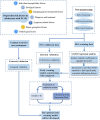Development and validation of a prediction model for depression in adolescents with polycystic ovary syndrome: A study protocol
- PMID: 36147974
- PMCID: PMC9486103
- DOI: 10.3389/fpsyt.2022.984653
Development and validation of a prediction model for depression in adolescents with polycystic ovary syndrome: A study protocol
Abstract
Introduction: The high prevalence and severity of depression in adolescents with polycystic ovary syndrome (PCOS) is a critical health threat that must be taken seriously. The identification of high-risk groups for depression in adolescents with PCOS is essential to preventing its development and improving its prognosis. At present, the routine screening of depression in adolescents with PCOS is mainly performed using scales, and there is no early identification method for high-risk groups of PCOS depression in adolescents. It is necessary to use a warning model to identify high-risk groups for depression with PCOS in adolescents.
Methods and analysis: Model development and validation will be conducted using a retrospective study. The study will involve normal adolescent girls as the control group and adolescent PCOS patients as the experimental group. We will collect not only general factors such as individual susceptibility factors, biological factors, and psychosocial environmental factors of depression in adolescence, but will also examine the pathological factors, illness perception factors, diagnosis and treatment factors, and symptom-related factors of PCOS, as well as the outcome of depression. LASSO will be used to fit a multivariate warning model of depression risk. Data collected between January 2022 and August 2022 will be used to develop and validate the model internally, and data collected between September 2022 and December 2022 will be used for external validation. We will use the C-statistic to measure the model's discrimination, the calibration plot to measure the model's risk prediction ability for depression, and the nomogram to visualize the model.
Discussion: The ability to calculate the absolute risk of depression outcomes in adolescents with PCOS would enable early and accurate predictions of depression risk among adolescents with PCOS, and provide the basis for the formulation of depression prevention and control strategies, which have important theoretical and practical implications.
Trial registration number: [ChiCTR2100050123]; Pre-results.
Keywords: LASSO regression; adolescents; depression; polycystic ovary syndrome; prediction model.
Copyright © 2022 Ding, Zhou, Yan, Liu, Guo, Tan, Wang, Wang and Wang.
Conflict of interest statement
The authors declare that the research was conducted in the absence of any commercial or financial relationships that could be construed as a potential conflict of interest.
Figures
Similar articles
-
Development and evaluation of a psychological adjustment communication system for adolescents with polycystic ovary syndrome at a high risk of depression: A mixed-method study protocol.Front Psychiatry. 2022 Nov 15;13:937280. doi: 10.3389/fpsyt.2022.937280. eCollection 2022. Front Psychiatry. 2022. PMID: 36458120 Free PMC article.
-
Depression in Girls With Obesity and Polycystic Ovary Syndrome and/or Type 2 Diabetes.Can J Diabetes. 2020 Aug;44(6):507-513. doi: 10.1016/j.jcjd.2020.05.015. Epub 2020 Jun 6. Can J Diabetes. 2020. PMID: 32792104 Free PMC article.
-
Clinical and metabolic characteristics of Turkish adolescents with polycystic ovary syndrome.J Obstet Gynaecol. 2018 Feb;38(2):236-240. doi: 10.1080/01443615.2017.1345875. Epub 2017 Sep 18. J Obstet Gynaecol. 2018. PMID: 28920502
-
Metabolic effect of obesity on polycystic ovary syndrome in adolescents: a meta-analysis.J Obstet Gynaecol. 2017 Nov;37(8):1036-1047. doi: 10.1080/01443615.2017.1318840. Epub 2017 Jun 28. J Obstet Gynaecol. 2017. PMID: 28657375 Review.
-
Polycystic ovary syndrome in adolescents with obesity.Rev Assoc Med Bras (1992). 2021 Mar;67(3):468-473. doi: 10.1590/1806-9282.20200890. Rev Assoc Med Bras (1992). 2021. PMID: 34468616 Review.
Cited by
-
Prevalence and associated risk factors for depression symptoms in adolescent girls with polycystic ovary syndrome: a hospital-based cross-sectional study.Front Public Health. 2024 Aug 21;12:1454415. doi: 10.3389/fpubh.2024.1454415. eCollection 2024. Front Public Health. 2024. PMID: 39234096 Free PMC article.
-
Assessment of the Validity and Quality of Polycystic Ovarian Syndrome (PCOS) Screening Tools Available for Women Globally: A Systematic Review.Clin Pract. 2024 Aug 23;14(5):1625-1649. doi: 10.3390/clinpract14050131. Clin Pract. 2024. PMID: 39311281 Free PMC article. Review.
-
PCOS in Adolescents-Ongoing Riddles in Diagnosis and Treatment.J Clin Med. 2023 Feb 3;12(3):1221. doi: 10.3390/jcm12031221. J Clin Med. 2023. PMID: 36769869 Free PMC article. Review.
-
[Research Progress in the Pathogenesis of Polycystic Ovary Syndrome].Sichuan Da Xue Xue Bao Yi Xue Ban. 2024 Jul 20;55(4):1049-1054. doi: 10.12182/20240760208. Sichuan Da Xue Xue Bao Yi Xue Ban. 2024. PMID: 39170002 Free PMC article. Review. Chinese.
-
Treatment and complications of PCOS in adolescents - what's new in 2023?Front Endocrinol (Lausanne). 2024 Oct 2;15:1436952. doi: 10.3389/fendo.2024.1436952. eCollection 2024. Front Endocrinol (Lausanne). 2024. PMID: 39415788 Free PMC article.
References
LinkOut - more resources
Full Text Sources



